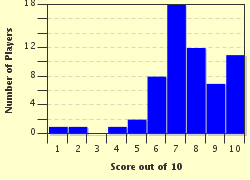Quiz Answer Key and Fun Facts
1. If you get on a flight to Vietnam that is heading for Tan Son Nhat International Airport, in which city - the largest in the country - will you land?
2. Vietnam is a long, thin country running along the eastern coast of which Asian peninsula?
3. The Battle of Bach-Dang River, that took place in the year 938, secured Vietnamese independence from which other nation?
4. Which river flows generally south-east from its source on the Tibetan (or Himalayan) Plateau to its mouth with the South China Sea in southern Vietnam?
5. Ha Long Bay in northern Vietnam is known for the large number of islands and islets dotted around it. From what type of rock are the majority of these formed?
6. Which 'nut', a popular ingredient in many Asian cuisines, is a major export product of Vietnam?
7. The Red River Delta region of northern Vietnam is home to which traditional form of theatre that developed as a type of local entertainment when the rice fields were flooded?
8. Arborophila merlini is an endemic bird species of Vietnam found in the dense forests of central northern Vietnam around the Annamite mountain range. By what common name is it known?
9. Fansipan, Vietnam's highest point at around 3,000 metres above sea-level, is located in which region of the country?
10. Popular tourist destination Phong Nha-Ke Bang National Park is noted for what type of geographic feature?
Source: Author
Fifiona81
This quiz was reviewed by FunTrivia editor
Tizzabelle before going online.
Any errors found in FunTrivia content are routinely corrected through our feedback system.
